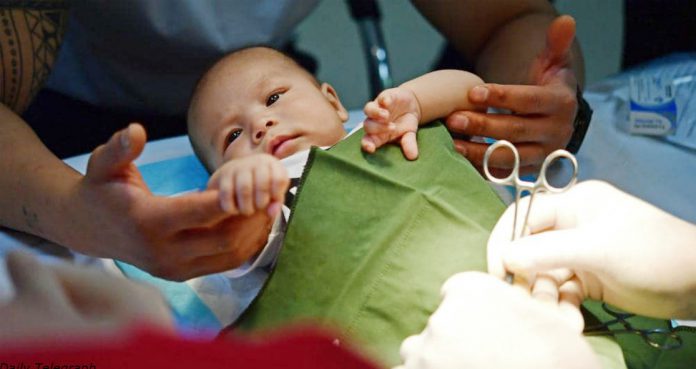Circumcision is a small surgical procedure in which the foreskin, aka prepuce, is removed from the penis. Although the origins of circumcision are unknown, it is majorly practiced by two major religious traditions.
Jews have been carrying out male infant circumcising for thousands of years and most Muslim men today get it done in their childhood.
According to the World Health Organization (WHO), it is estimated that more than 30 percent of the world’s males aged 15 years or above are circumcised. Of which, nearly 1 percent are Jewish, 69 percent are Muslim, and 30 percent are circumcised under non-religious backgrounds. Of that 30 percent, over 43 percent are in the United States.
The tradition of non-religious circumcision among healthy infants in the United States started in 1870s when a New York surgeon Dr. Lewis Sayre developed a theory that circumcision could help in curing multiple diseases – such as impotence, STDs, seizure disorders, homosexuality, bedwetting, and paralysis – by calming the nervous system.
However, from a medical perspective, there have been ongoing debates on the scientific evidence regarding health implications caused by circumcision. The procedure has been shown in the literature to have some health benefits. Studies have found that it could help reduce the risk of penile cancer, phimosis, STDs, and balanitis. It has also been found to reduce the risk of contracting HIV.
The health benefits of circumcising are too small to recommend or mandate the procedure, yet the risks are too small to forbid it. Therefore, the American Academy of Pediatrics states, “Although health benefits are not great enough to recommend routine circumcision for all male newborns, the benefits of circumcision are sufficient to justify access to this procedure for families choosing it.”
What’s more concerning is the ethical argument of circumcision, where some experts believe that surgical removal of healthy and functional body tissue without medical necessity or consent is a violation of basic human rights.
Evidently, infant circumcision does not meet either criterion.
A leading scholar on the issue Brian Earp says, “Consider labiaplasty (surgical cutting of the labia). It is similar to circumcision in that it removes genital tissue that is involved in yet not necessary for sexual enjoyment, and in that the genital tissue in question requires regular good hygiene, can become infected or even cancerous, and is involved in people’s assessment of genital aesthetics.”
“Given these similarities, we can assume that removing the labia will produce both health and psychosocial benefits for some women,” he added.
“Would we approve of non-voluntary neonatal labiaplasty in the US under these conditions? Unlikely,” said Earp.
“This is because there is quite a broad agreement in our culture that 1. Healthy, functional bodily tissue is valuable in and of itself, and removing such tissue permanently without consent is wrong if other means exist to prevent and treat rare potential problems associated with maintaining it. 2. Girls have rights, including the right to genital integrity; the right to grow up with their genitals intact and decide for themselves, when they are properly able, whether and which parts they would like to keep, alter, or chop off.” This concludes that the potential health benefits of infant circumcision can be reaped through non-surgical means or through performing the procedure later after getting the consent.























